Should we go by the books, or is it actually worth investing in a unique typeface for your logo? Let’s see when this choice pays off.
Most fonts were made to be used by everyone. That’s it, that’s the problem. If your logo is built on something millions of other brands can download in seconds, it’s already at risk of blending in.
Custom typography solves that by giving you something no one else has. It takes the idea further by doing what off-the-shelf fonts rarely can. Custom typography in a logo lets you design the rhythm, weight, and attitude of every letterform. Nothing is borrowed, nothing is reused; it’s built for one name only.
However, custom work is not for the weak. No, we don’t mean it’s out of the question, but it does come with a cost, and not just financial. It demands clarity about who you are and how you want to be seen. That’s why it’s not the right choice for every brand out there.
Plenty of other great logo design fonts can do the job for you. But when the usual font libraries start to feel like a crowded room, custom typography offers a quiet exit.
So, when is it worth investing in a typeface no one else has? And when is it better to work with what’s already out there? Find out for yourself.
What is Custom Typography and Why Does It Matter
Custom typography in logo design, often known as bespoke type design, is when the letters in a logo are created or modified specifically for one brand. It’s not pulled from a font menu. It’s drawn with intention, often starting from scratch or heavily adjusting an existing style until it feels unique, ownable, and aligned with the brand’s voice.
It’s different from choosing a commercial or free font that is available to anyone. Those are designed for general use. They can still be effective when chosen thoughtfully, but they rarely offer true originality. Custom typography, on the other hand, gives a brand full control over how its name looks, down to the tiniest detail.
Brands using custom typography to build a unique identity for the audience
To make you understand better, here are some famous logos that make good use of custom logo typography and lettering to leave an impact.
• Coca-Cola – Spencerian Script
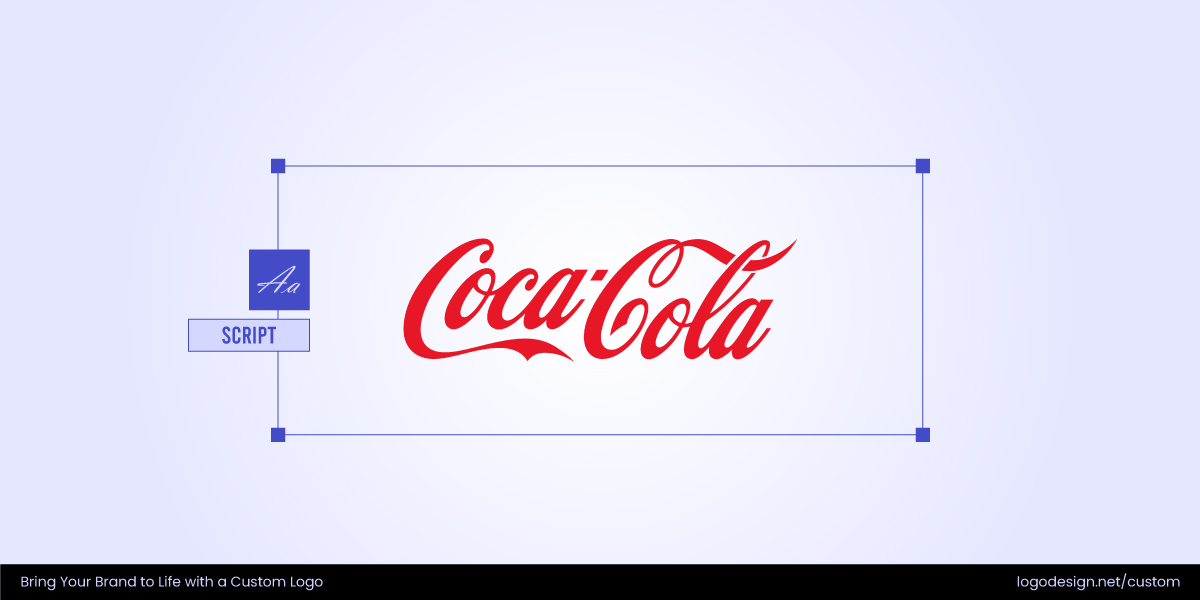
The Coca-Cola logo using a hand-drawn typography that has remained the same since the beginning
Coca-Cola’s logo is built on a custom version of 19th-century Spencerian script. It was hand-drawn in the 1880s and has barely changed since. The fluid, ornate curves reflect a sense of tradition, familiarity, and timelessness, perfect for a brand that sells nostalgia as much as it sells beverages. Its lettering is woven into its product identity.
• Google – Product Sans
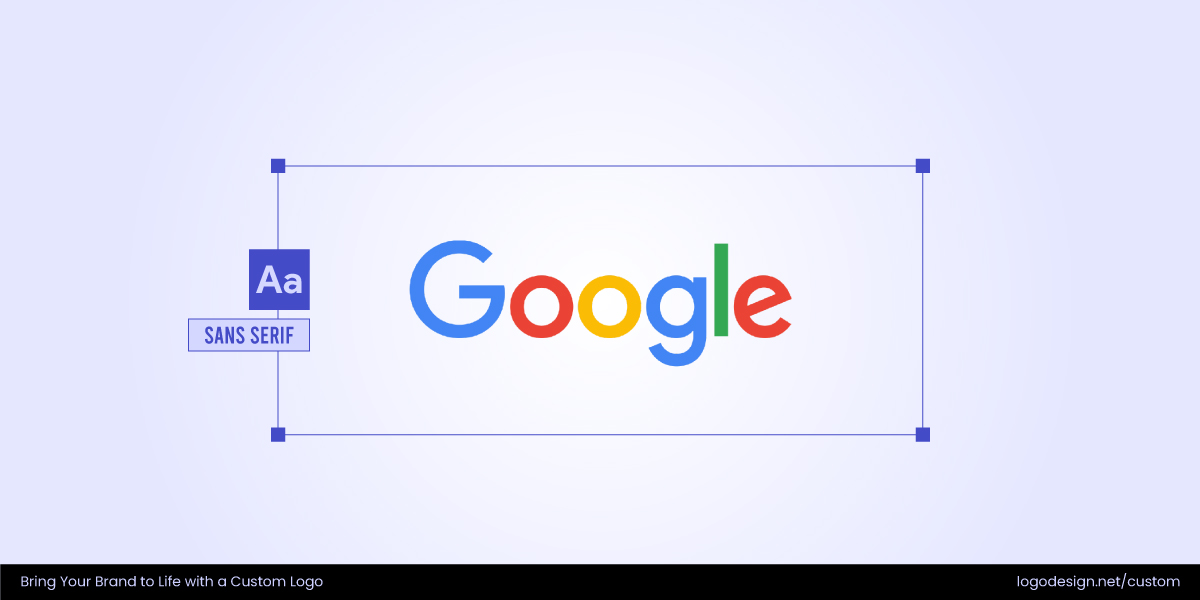
Google using a custom typeface to show simplicity and friendliness
Google replaced its old serif wordmark with Product Sans, a geometric, custom typeface developed in-house. It’s clean, friendly, and incredibly simple, but not generic. The subtle tweaks in proportion and spacing give it a warmth that suits Google’s open, accessible, and modern tone. It’s also designed to scale well across devices, which matters when your logo shows up everywhere.
• Airbnb – Custom “Bélo” Wordmark
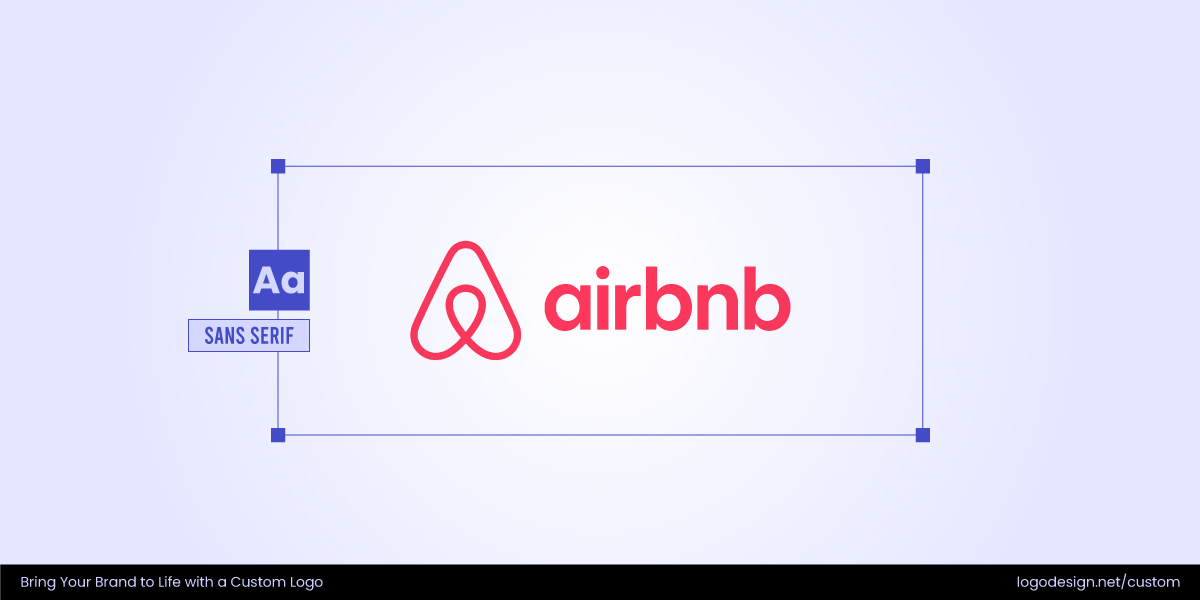
The rebranded 2014 Airbnb logo, using a custom workmark which feels approachable
Airbnb’s rebrand in 2014 introduced the Bélo, a symbol and a custom wordmark that balances rounded forms with a modern, approachable feel. The type was created to echo the curves of the symbol and convey inclusivity and belonging, core parts of Airbnb’s brand promise. The lettering feels human, but also tech-savvy, striking a perfect balance between trust and innovation.
Benefits of Using a Unique Typeface
Custom typography in logos offers strategic advantages that can strengthen your brand from the ground up. Whether you create a customized version of a serif or a sans-serif typeface, it quickly becomes a core part of how your brand communicates.
Here are the most common benefits you get:
1. Originality: Stand Out in a Crowded Market
Perhaps, the greatest of all, originality is what most brands crave. In industries where everyone looks the same, a unique font style impacts brand perception and can help you break through the noise. So, it’s different not just for the sake of it, but instead with a purpose.
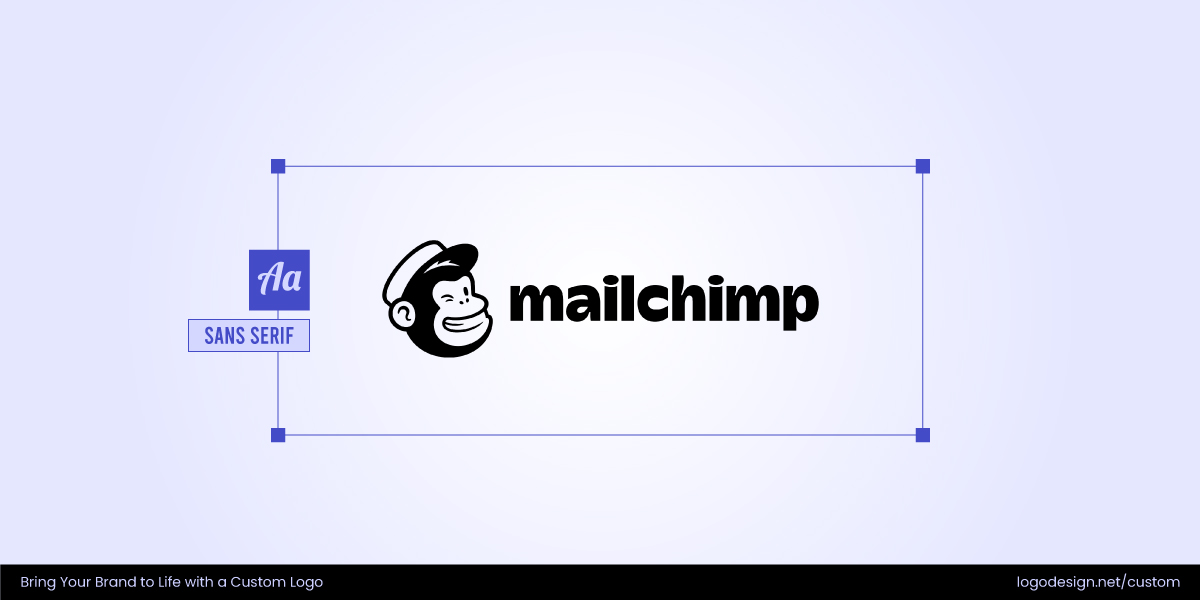
The Mailchimp logo using a hand-drawn wordmark for a techy look
You can learn it from Mailchimp. Its hand-drawn, quirky wordmark sets it apart from the sea of sleek, techy sans-serifs in the software space. The custom type reflects the brand’s offbeat tone and adds personality in a category that often plays it safe.
2. Brand Identity: Reinforce Tone, Values, and Personality
Typography has a voice. A custom typeface allows you to fine-tune that voice until it matches exactly how you want your brand to be perceived, like serious, playful, elegant, bold, or anything in between.

The Chobani logo using a custom serif typeface that matches the brand’s neutral identity
Chobani’s rebrand is a good example. Its text logo with a custom serif typeface, soft curves, and organic shapes, perfectly matches the brand’s natural, wholesome identity. The letterforms feel approachable and honest, just like the product.
3. Timelessness: Prevent Your Logo from Feeling Trendy or Outdated
Design trends around colors and fonts come and go, but custom typography can help your logo stay relevant for decades. Since it’s not tied to any specific design fad, it’s less likely to age poorly.
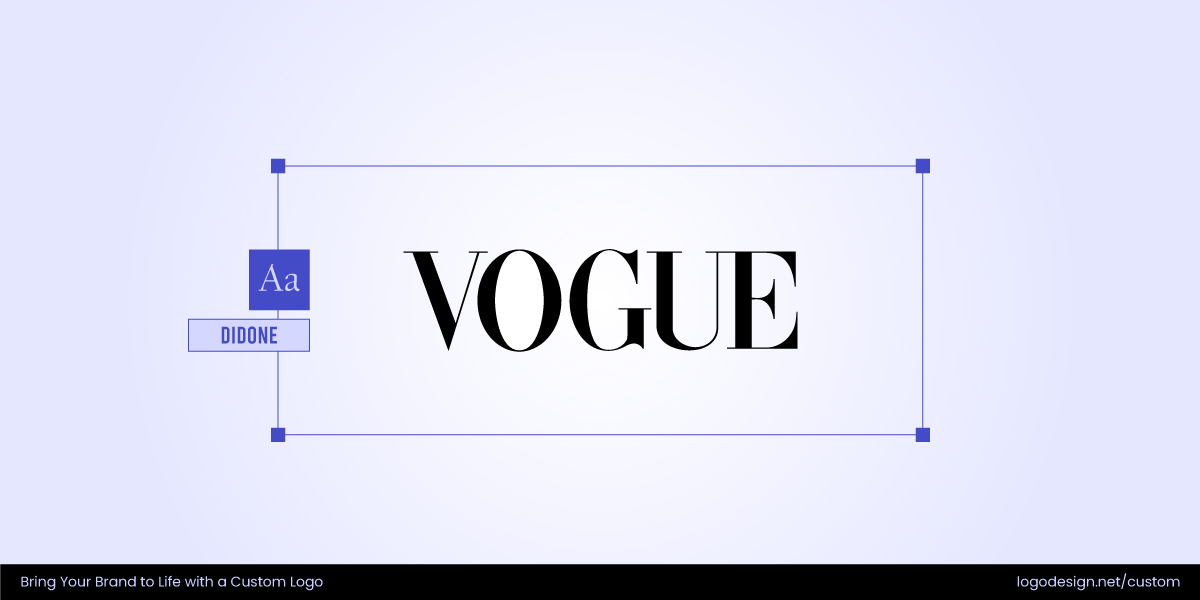
The Vogue logo using a modified Didone typeface with high contrast, which has barely changed
Vogue has used a custom-modified Didone typeface for decades. Its refined, high-contrast lettering has barely changed, and still feels modern, which is proof that tailored typography can outlast changing design trends.
4. Trademark Potential: Easier to Legally Protect a Unique Design
Since a custom typeface is original artwork, it is much easier to trademark and legally defend. This is especially important for wordmark logos or alphabet logos, where the lettering is the brand.

The Pinterest logo using a custom typeface with smooth curves for brand consistency
Pinterest redesigned its logo with a custom typeface that incorporated subtle curves and ligatures to echo the shape of its iconic “P” symbol. This helped reinforce brand consistency and made the wordmark more protectable from copycats.
When to Use Custom Typography in a Logo
Not every brand needs custom typography and fonts, but for those that do, it can be that detail that pulls everything together. Let’s learn when investing in unique letterforms makes the most sense.
1. You’re Building a High-End or Heritage Brand
You must have noticed that luxury brands tend to stick to designs that feel exclusive, minimal, and classy. Backed by these traits, they build equity through trust, tradition, and lasting presence. Off-the-shelf fonts, however, rarely carry that kind of weight. Custom typography in logo design gives you the flexibility to add that sort of elegance, restraint, or character.
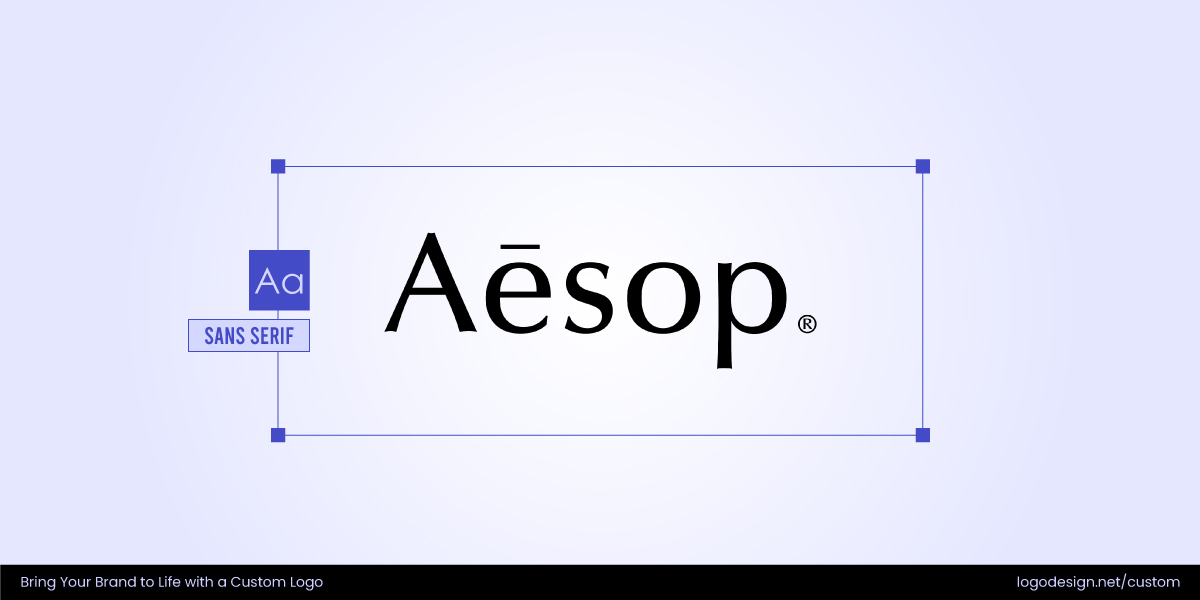
The Aesop logo shows simplicity and minimalism to signal attention to detail
A perfect example of this would be Aesop, whose refined and restrained bespoke Optima type fits the brand’s minimalist, high-end philosophy. The brand doesn’t make the common typography mistake of going all in with the design. They keep it simple, signaling quality and attention to detail.
2. Your Brand Name Is the Main Focus (Wordmark/Lettermark)
When your logo is just your name, the typography is the design. Since there’s no icon to fall back on, you need to make sure each letter plays its part to be memorable. That’s where a custom approach shines. It ensures each letter is legible, distinct, and built to be remembered. This level of precision also helps create visual rhythm, so the logo feels cohesive no matter where it’s placed.
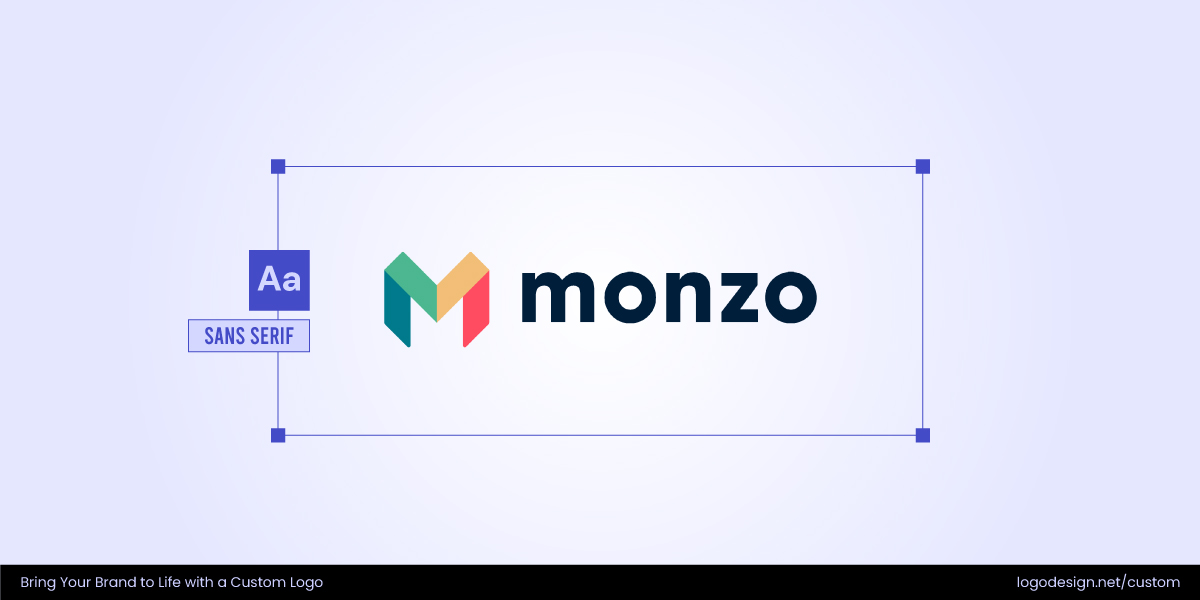
Monzo using a clean wordmark to create an approachable and modern appeal
Monzo, the UK-based digital bank, uses a clean, extra bold wordmark with slightly altered geometry to create its own rhythm. It’s approachable, modern, and distinct enough to be recognized instantly, even without an icon.
3. You Need a Logo That’s Distinct Across Mediums
Your logo won’t live in one place; it will be stretched, shrunk, printed, and displayed on screens of every size. A custom typeface allows you to fine-tune kerning and tracking, balance proportions, and stroke weight so it’s equally strong on a billboard and inside an app icon. This kind of logo makes sure you never lose impact.
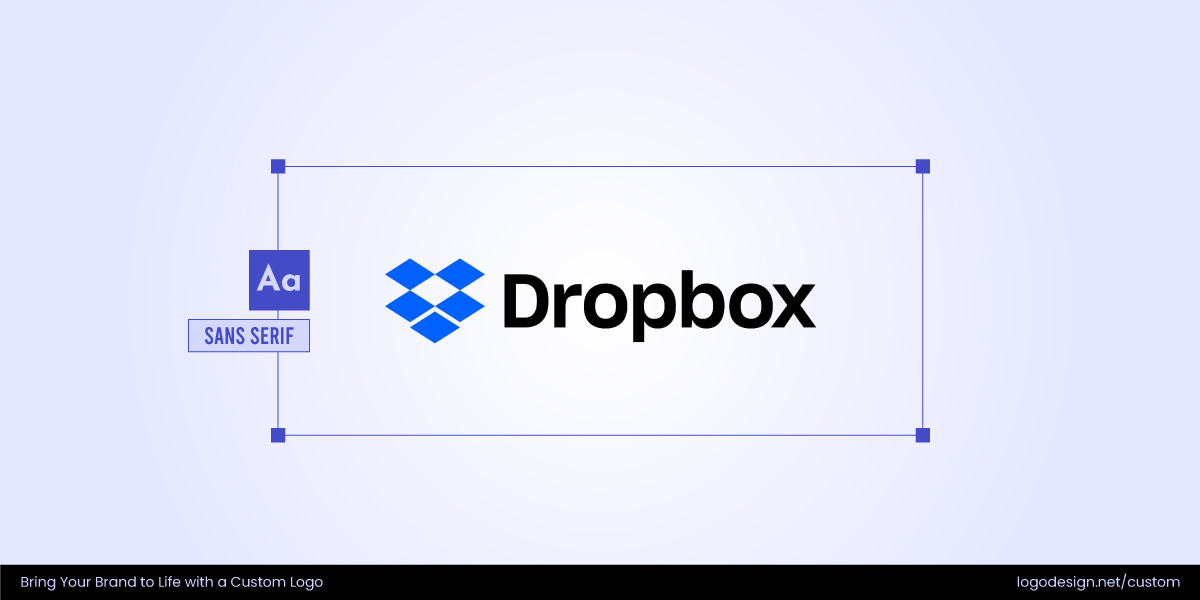
The Dropbox logo using a custom typeface that’s spaced well and shows simplicity
Dropbox is a good example. Their custom wordmark is simple, but its spacing, proportions, and letterforms are all carefully tuned to hold up across screens and print, without losing personality.
4. Your Competitors All Look the Same
When brands in the same space use matching fonts and colors, they start to blur together in customers’ minds. A custom typeface helps you step outside the visual norms of your category and create a brand voice that’s entirely your own.
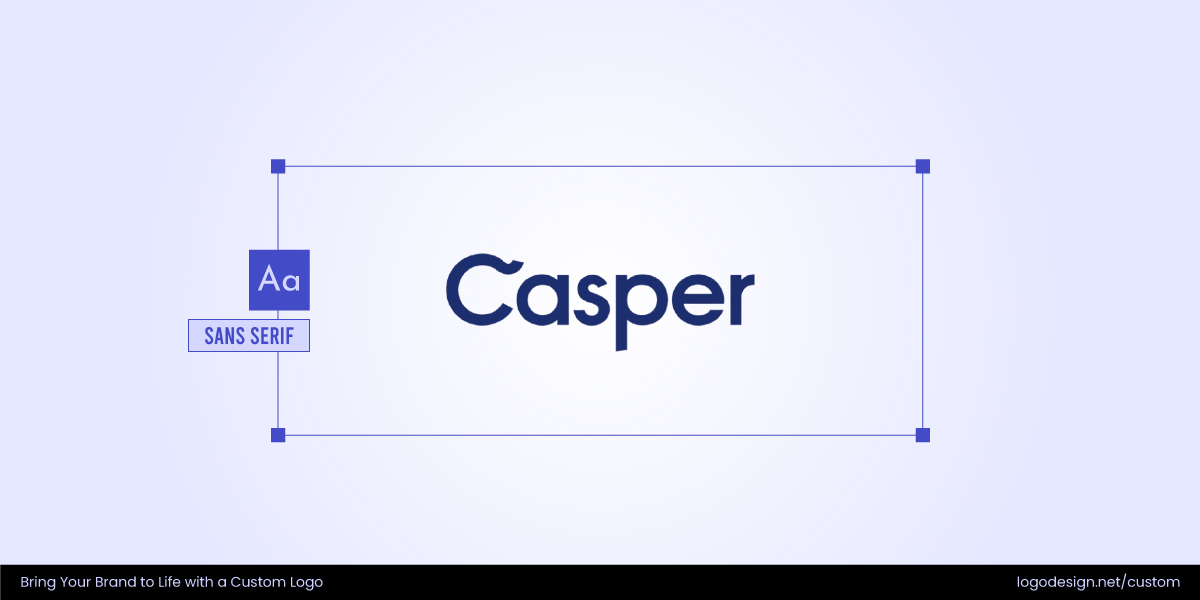
The Casper logo using a custom typeface to show a relaxed appeal
That’s where you should go for a custom typeface that carves out your visual space, just how Casper did. The mattress brand recently introduced a custom logotype that feels softer and more relaxed than the sharp sans-serif used by many other DTC brands. It supports the idea of comfort without being obvious or overly styled.
5. You’re Rebranding and Want a Clean Break from the Past
Sometimes, a new typeface marks a new chapter. When a brand evolves or pivots, custom typography visually signals “this is something new” and distances it from past baggage. It’s especially powerful when the previous logo feels dated or too closely tied to an old identity. It’s often the fastest way to visually reset your identity without needing a complete overhaul.
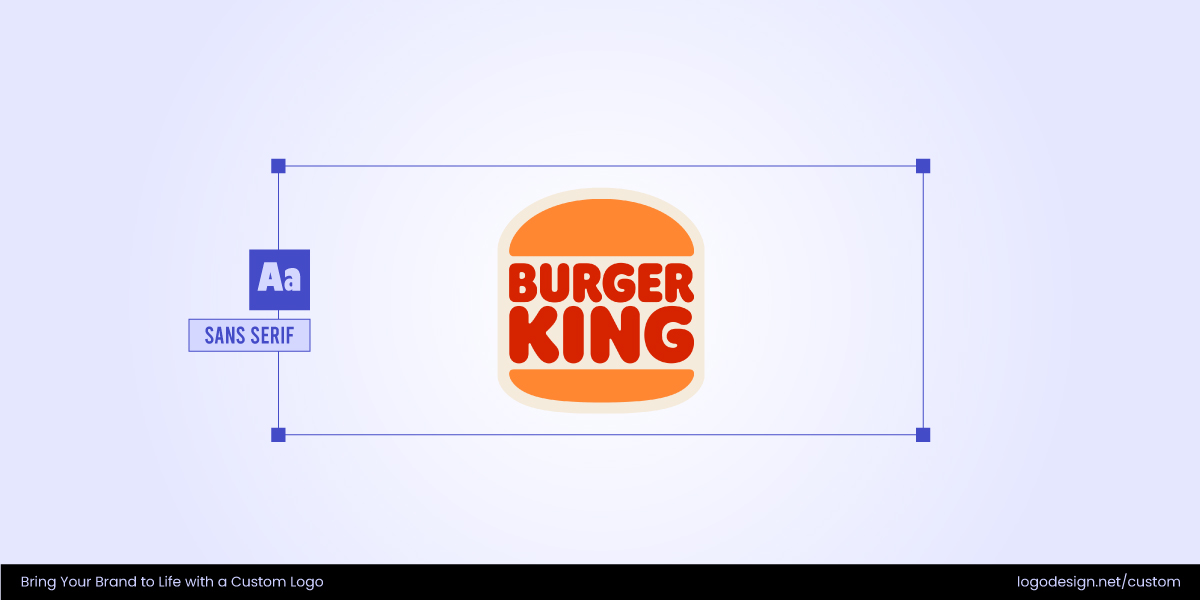
The rebranded 2021 Burger King logo using a retro-inspired custom typeface for a fresh look
When Burger King rebranded in 2021, it brought back a retro-inspired custom typeface that ditched the overly polished, modern look they’d had for years. It helped them reconnect with their roots while still feeling fresh and current.
6. To Express a Specific Aesthetic
What to do when your brand vision demands a style that doesn’t exist in pre-made fonts? Custom fonts bring you the best typography for logo design. Whether the goal is retro elegance, futuristic minimalism, handcrafted charm, or completely off-beat, you can design for that exact mood. Every curve, angle, and proportion can be tailored to support the brand’s atmosphere.
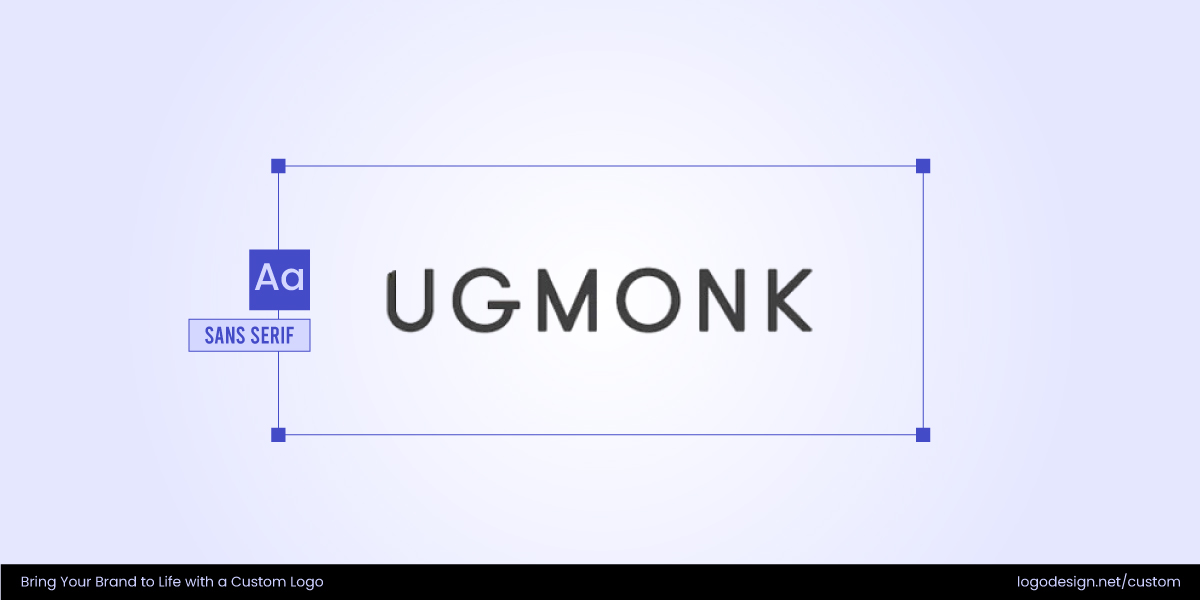
The UKmong using a simple hand-written typeface with thin strokes to show minimalism.
Ugmonk, a small lifestyle brand, wanted a type that would match the tone of their minimalist, thoughtful products. They achieved it with a hand-drawn custom wordmark that leans into a crafted and artisanal feel. It looks perfect at first glance!
When You Don’t Need Custom Typography
Remember when we said that choosing a custom typeface might not always be the smartest route? Sometimes, going with an existing font is more practical. Let us explain to you why and when.
1. Startups or Small Businesses with Tight Budgets
If you’re just getting started and need to stretch every dollar, investing in a custom typeface may not make sense. At this stage, you might be better off focusing on building your audience and refining your brand story. Many of the best typography logo options out there actually began with a well-chosen, off-the-shelf font before moving into custom territory later.
2. Brands That Rely More on an Icon or Symbol Than Text
If your main brand recognition comes from an icon, your typeface may play more of a supporting role. In that case, spending heavily on a custom font might not be the best move.
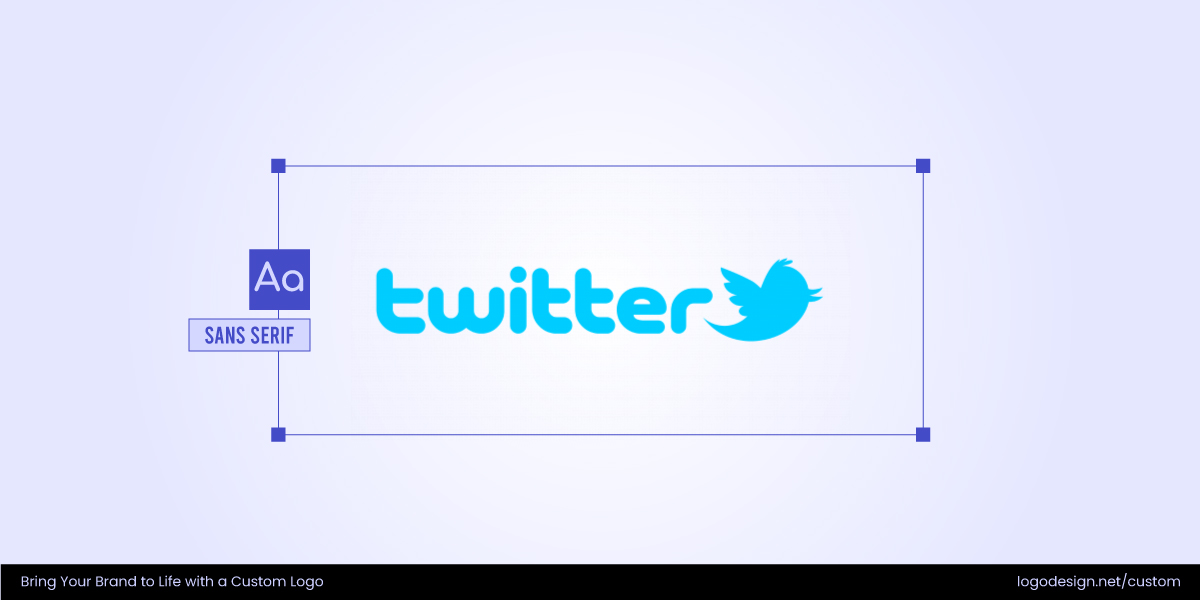
The earlier Twitter (now known as X) logo used a bird icon to become recognizable
Take Twitter (now X) in its earlier years, its bird icon was far more recognizable than its wordmark, so the type was secondary.
3. When a Well-Chosen Existing Font Can Already Capture the Brand Personality
Sometimes, you don’t need to reinvent the wheel. There are thousands of fonts that can spark unique typography logo ideas without the time or cost of creating something from scratch.
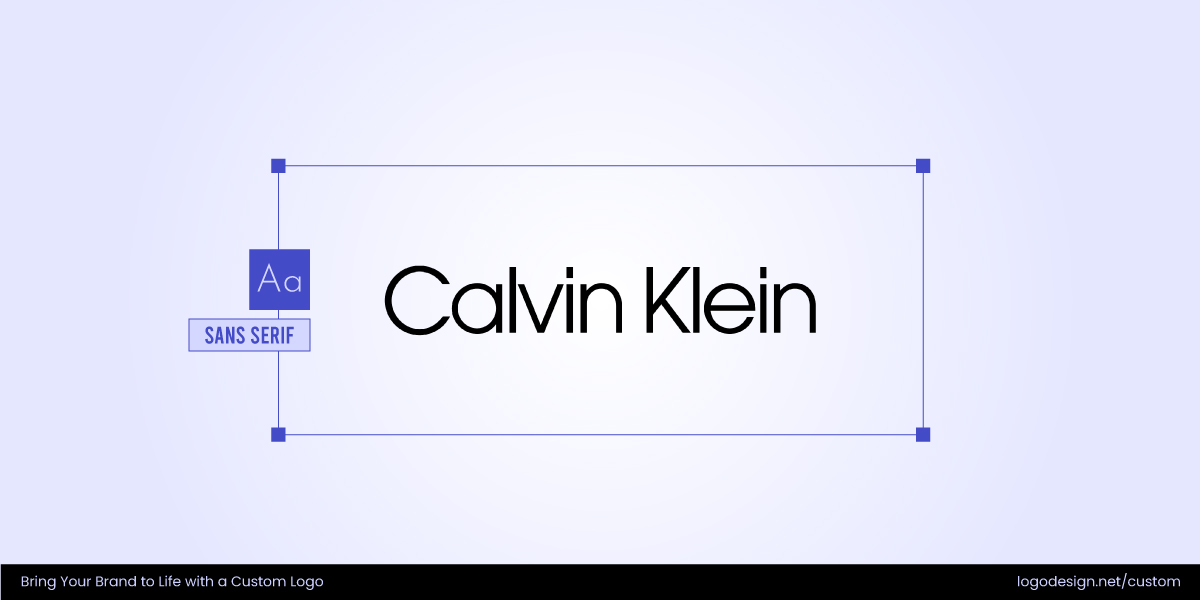
The Calvin Klein logo using a clean and minimalist appeal with a sans-serif font
For example, Calvin Klein has long used a clean, minimalist sans serif (ITC Avant Garde Gothic) with slight tweaks, proving you can still achieve one of the best typography logo design outcomes without going fully custom.
4. Short-Term or Experimental Projects
If your brand or campaign has a short lifespan, investing in a custom typeface is rarely worth it. Instead, focus on finding a readable font that captures the right mood quickly so you can allocate resources to marketing, packaging, or other essentials.
How to Approach Creating Custom Typography
Custom typography in logo design can be a powerful brand asset, but only when done right. The process is part art, part strategy, and requires balancing creativity with functionality. Keep these tips in mind when creating a logo:
- Collaborate with a skilled logo designer or type designer: A specialist understands how to create letterforms that are both aesthetically pleasing and practical for branding. They’ll also make sure your typography works across different formats and platforms.
- Consider legibility and scalability (especially in small sizes): Fancy flourishes might look great on a poster, but could disappear on a mobile app icon. Test your design at multiple sizes to ensure it remains clear and recognizable everywhere.
- Keep it simple, don’t overdesign: Overly complex letterforms can be distracting and date quickly. A clean, timeless design will stay relevant longer and adapt better to future branding needs.
- Ensure consistency across all branding materials: Your typography should look the same whether it’s on your website, packaging, or social media posts. Building a versatile logo ensures brand recognition and trust over time.
Bonus Tip: Before committing to a design, create mockups of your logo on real-world items like business cards, signage, or social media headers. Seeing it in context will help you spot potential issues early.
Custom Typography Designers to Inspire Your Next Logo
If you’re thinking about going custom, it helps to see how the pros do it. Here are some talented type designers whose work shows the art and precision behind bespoke lettering. Each brings their own style, from intricate scripts to clean, modern letterforms, perfect for sparking ideas for your brand’s typography.
1. Tobias Saul
A lettering artist from Düsseldorf, Germany, Tobias is known for his richly detailed, vintage-inspired typography. His work often combines ornate flourishes with strong composition, making it ideal for premium and heritage brands. You’ll find everything from bold display type to elegant script work in his portfolio.
2. Viktor Baltus
Viktor creates type with a strong conceptual backbone, often exploring geometric structures and unexpected textures. His designs stand out for their ability to merge classic typographic principles with playful, experimental twists that feel fresh yet timeless. He teaches 1000+ students in his Type Design Class.
3. Adam Greasley
Founder of Oakfold Design, Adam is a UK-based designer who crafts lettering that balances tradition with modern appeal. His work often features crisp, hand-drawn letterforms that are both versatile and full of personality, making them perfect for distinctive branding.
4. Lauren Hom
A lettering artist with a knack for bright colors, clever wordplay, and eye-catching compositions, Lauren’s work radiates joy and personality. Her pun-filled designs and approachable style have built her a loyal online following. She often shares behind-the-scenes looks at her creative process, making her feed both inspiring and educational.
5. Wael Morcos
Wael is celebrated for his innovative approach to Arabic and Latin typography. He often blends both scripts in ways that feel organic and visually stunning. His designs push the boundaries of multilingual type, showing how letterforms can bridge cultural and aesthetic worlds.
6. Ulteriooor
Known for breaking the rules of conventional typography, Founder and Creative Director of Holographik loves experimenting with extreme proportions, abstract shapes, and layered textures. The result is bold, highly individual type work that commands attention and challenges traditional logo aesthetics.
7. Jessica Hische
Known for her whimsical, detail-rich lettering, Jessica’s work spans book covers, branding, and editorial projects. She has collaborated with major clients like Wes Anderson, Penguin Books, and Mailchimp to create a playful yet meticulously crafted type. Her style blends decorative charm with sharp typographic precision.
8. Erik Marinovich
Co-founder of Friends of Type, Erik creates bold, concept-driven lettering that often bursts with color and personality. His designs range from expressive brush scripts to clean wordmarks, making his portfolio a masterclass in versatility.
9. Martina Flor
A Berlin-based lettering artist, Martina combines calligraphic elegance with modern design sensibilities. Her work often features flowing curves, precise detailing, and a strong sense of composition. Her work inspires brands looking for sophistication with a human touch.
10. Gemma O’Brien
An Australian artist and designer, Gemma is celebrated for her large-scale murals, typographic installations, and playful lettering. Her work blends bold color, organic shapes, and experimental letterforms that transform words into immersive art experiences.
Examples of Custom Typography in Action
What better way to see the power of custom type than to see it in action? These brands cleverly make use of unique letterforms to show off their personality and persona at first sight. Who knows, they might just spark your next logo idea.
1. Muji: Minimalist, Calm, and Unmistakable
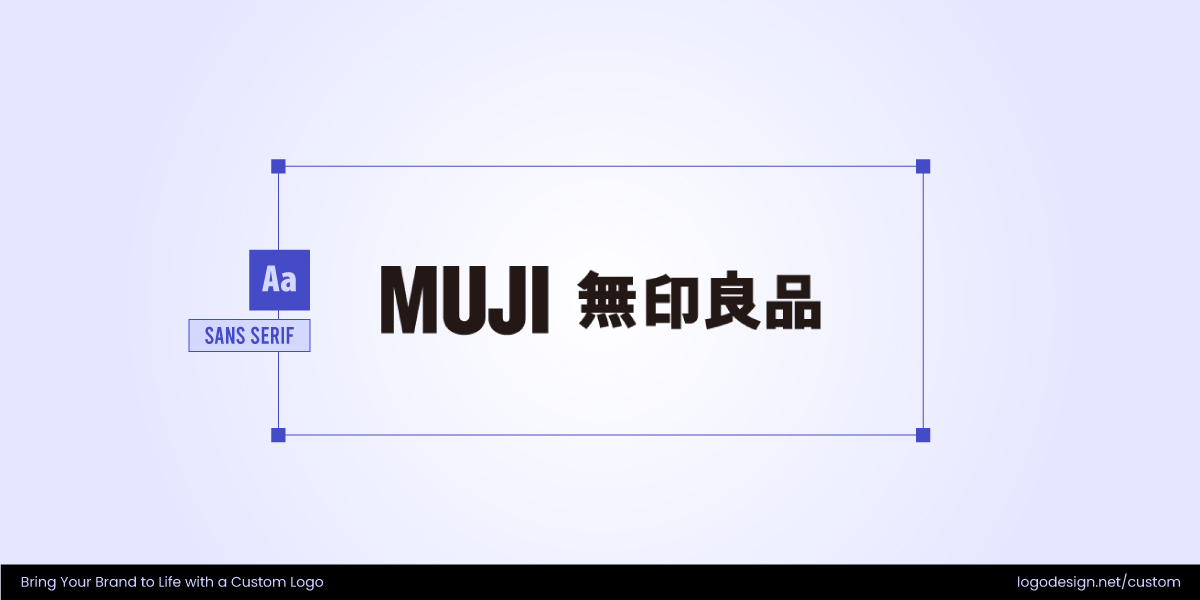
Muji using a customized sans-serif with clean lines to trigger a sense of calmness
Muji’s custom sans serif, inspired by Helvetica Neue but subtly refined, reflects the brand’s “no-brand” philosophy. Its clean lines and generous spacing evoke a sense of calm, order, and simplicity that perfectly mirrors Muji’s pared-down, functional products.
2. Ben & Jerry’s: Fun You Can Read

The Ben & Jerry logo using a hand-drawn typeface, which brings a playful flavor
The ice cream giant’s chunky, hand-drawn typeface, designed by The Font Bureau, captures the brand’s friendly, slightly rebellious vibe. The uneven strokes and rounded edges make the logo feel approachable and joyful, just like the playful flavors and social activism Ben & Jerry’s is known for.
3. Vice: Bold, Edgy Lettering with a Graffiti-Inspired Style
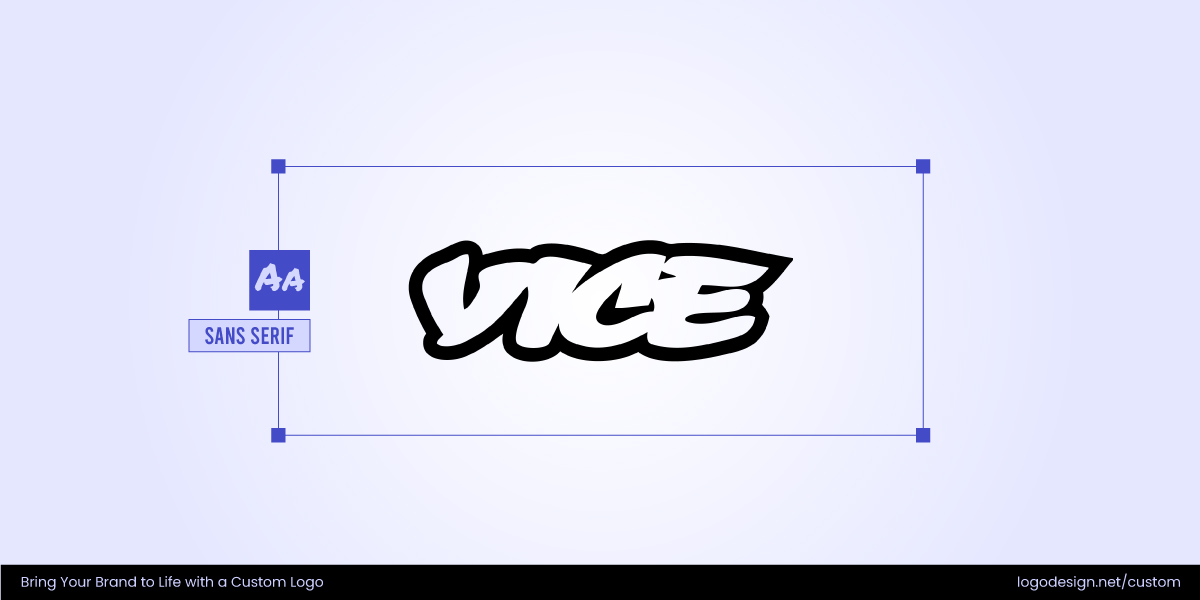
The VICE logo using a thick custom typography with a freehand feel
Vice’s custom typography blends thick, high-contrast strokes with a freehand, street-art feel. It perfectly reflects the brand’s rebellious, youth-driven media voice, making it instantly recognizable across everything from magazine covers to video thumbnails.
4. Rapha: Hand-Scripted with a Premium Sporting Edgy
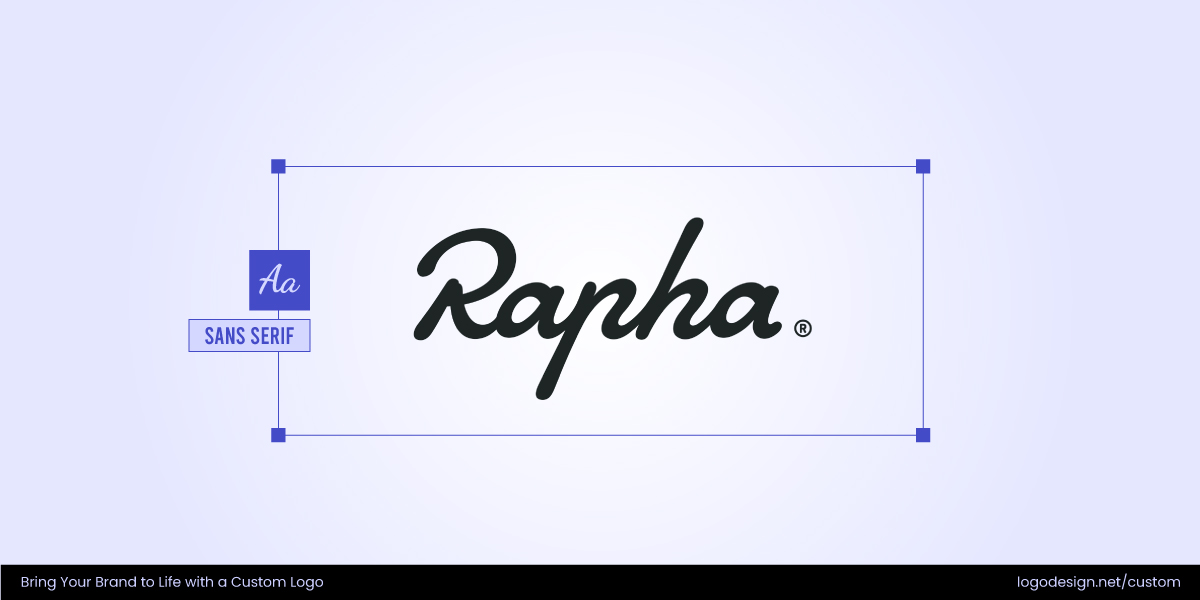
The Rapha logo using a custom script-inspired font that conveys heritage
Rapha’s cycling apparel logo features a custom cursive script inspired by classic racing jerseys. The flowing, confident strokes convey both heritage and high performance, appealing to serious cyclists who value craftsmanship.
5. Monocle: Sophisticated Serif with Editorial Precision
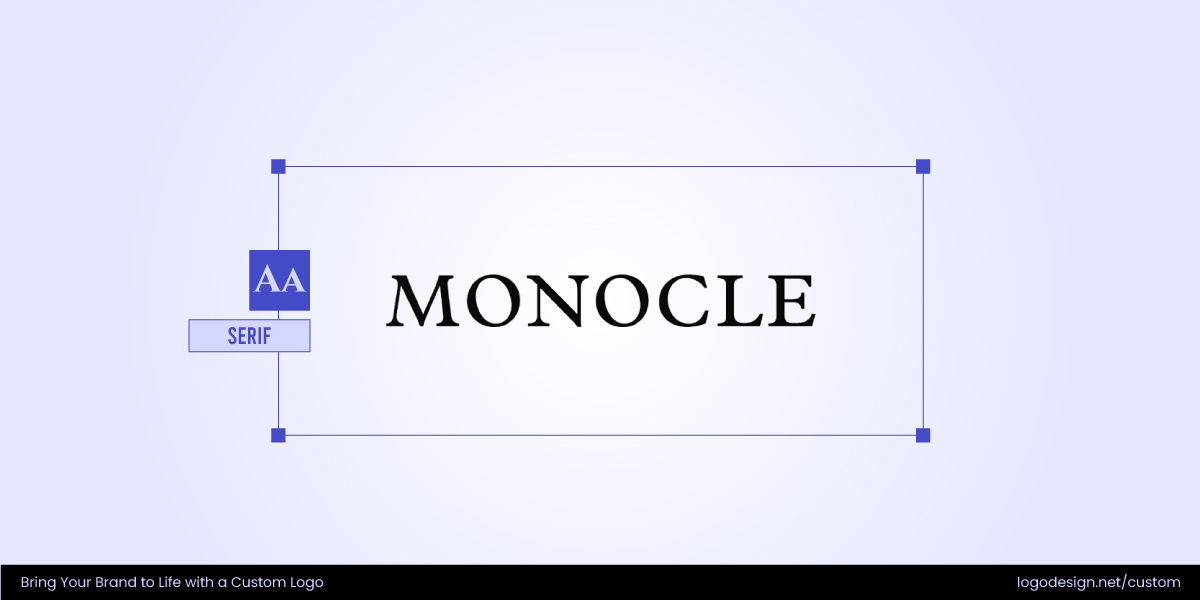
The Monocle logo using a custom typography with sharp edges to show a modern appeal
The Monocle logo uses a bespoke, sharply cut serif typeface that mirrors the magazine’s global, refined, and detail-oriented brand identity. The letterforms are timeless yet modern, instantly evoking premium journalism.
Key Takeaways
- Custom typography makes a brand own its voice. Bespoke letterforms create recognition that off-the-shelf fonts rarely deliver.
- It’s a strategic choice, not a stylistic one. Use custom type when it supports a clear business goal, such as distinctiveness, heritage, or cross-platform performance.
- Custom fonts are not always the right choice—small budgets, short-term projects, or brands relying on strong icons may be better off with an existing font.
- Many big brands, including Coca-Cola, Google, and Airbnb, use custom typography in logos.
- Legibility and scalability should guide every decision; ornate details that fail at small sizes are a liability.
- A custom typeface becomes an asset only if it is consistently applied across products, packaging, and digital touchpoints.
So, are you ready to go full custom, or do you want to dig into typography logo ideas first? Our logo maker can help you design a logo that speaks your brand’s language. Give it a try!
